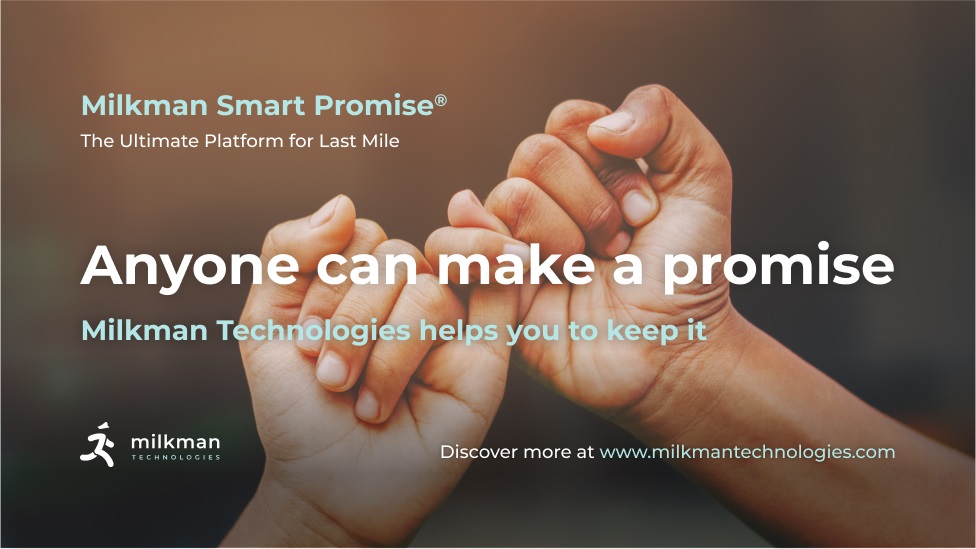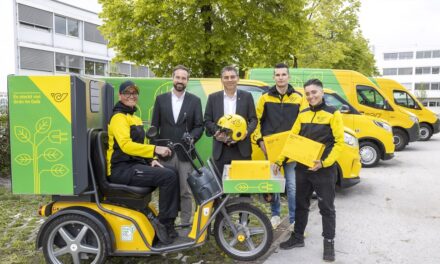
Mastering the Art of Delivery: Promises Kept from First to Last Mile

Antonio Perini, CEO of Milkman Technologies, discusses the significance of the “LAST MILE” and explores how the logistics industry can benefit from cutting-edge last mile delivery solutions.
Why do we talk about First and Last mile in logistics?
Let’s think about the concept of the “reverse journey” that a package undergoes throughout its lifespan, starting from the final customer’s hands and returning to its original order point. Frequently, this journey is misconceived as a series of mandatory stops that the package must make to reach its destination. Everything should be perfectly connected for a seamless and successful journey from end to start.
The package has been successfully delivered to the final customers and is now in their possession. The driver reached the destination and confirmed the delivery, following the correct route and arriving on time. During the route, the driver efficiently managed to pick up and collect on-demand orders as predicted and communicated by the system. The package was initially loaded into the driver’s van with the correct information attached to it. Upon reaching the last-mile depot, the package was collected and loaded onto the appropriate van by depot personnel. The depot manager was well-informed about which van the package should go in and what information was necessary. Before arriving at this specific depot, the package had to be delivered on time through line hauls that connected it to the depot of origin. This process is similar to the one at the destination depot and can occur either from a shipper’s warehouse or when a shopper returns an item or sends it to the second-hand market.
It can seem simple if you only think about it in blocks, but it requires the collaboration of multiple actors managing multiple steps to make the whole process work smoothly predicting and avoiding possible mistakes.
The key is to give all the different players involved throughout the entire supply chain journey consistent information and full visibility so that the delivery journey starts, proceeds, and arrives at the final destination successfully, even when disruptions occur.
Rethinking the Focus: Is It Wrong to Solely Discuss the Last Mile?
When we talk about the Last Mile, our first thought often goes to the end customers, be they shoppers or businesses. However, there’s a lot more happening behind the scenes. It’s more accurate to discuss the First to Last Mile delivery process because it reflects how the journey begins, unfolds, and concludes. In most orders, multiple players are involved in various steps along each leg of the supply chain. Typically, these players operate in isolation, each focused on finalizing their respective processes while attempting to reduce costs. However, when we consider Last Mile delivery, we’re addressing the most critical point in the supply chain, where all the previous steps converge to deliver the final product and fulfill the delivery promise. By effectively orchestrating all these preceding phases and providing visibility to all involved parties, we can make delivery promises that are reliable, intelligent, and sustainable. This is why we’ve introduced our cutting-edge solution: the Milkman First and Last Mile Platform. It’s designed to orchestrate the end-to-end journey from pick-up to drop-off across the entire distribution network. It leverages full automation to determine resources and capacity, visualize routes on both maps and timelines, and centralizes execution management policies to address First and Last Mile logistics requirements. Failing to closely coordinate your Last Mile operations with your First Mile operations poses a concrete risk of failing to fulfill your delivery commitments. However, when you connect all the dots by aggregating relevant data from the First Mile to the Last Mile, you can transform this information into logistics instructions using automation and reliably deliver as expected.
Which elements should be considered the most important throughout the order journey just described?
First of all, look for Digitalization technologies that can be scalable and adaptable. Many technologies nowadays offer a solution to most problems, but real change can be provided only by those technologies that can offer optimization and can increase the value of each delivery thanks to their agility.
Automation helps carriers and retailers become leaner, and more customer friendly. The ability to simplify a crowded system that goes from manual operations to digitized systems will touch every single step of the logistics process and can eliminate the hurdles created by paper logs and different systems not communicating with each other. Automation has the capability to turn all the customers’ expectations into optimized operational instructions.
Back in the depot, on the road and at the doorstep the information sharing about the delivery needs to be consistent and on time. Communication is crucial in making sure all involved parties have an overview of the process from start to finish. The Last Mile, as the most digitalized part of the supply chain, plays a crucial role in this. It has a direct connection with the end customer, but it can also serve as a data collector for the whole process and gives important information back to the first mile to always improve the journey, and here you can see how the loop closes.
Why does Milkman Technologies talk about ‘Smart Promise’?
Well, promising is a very delicate and interesting concept. How many times in our life have we said ‘’I promise you’ but many times failed in keeping that promise? A smart promise means establishing and overseeing recipients’ expectations that can lead to improved perceptions among both recipients and shippers, while simultaneously achieving significant cost saving. As mentioned before, there are many parts and players involved from the First to Last Mile process and everything needs to work together in order to function at its best. The Smart Promise solution does exactly that, considers the needs of the carrier and the customers, connects the different dots and adapts depending on the requests and the planning. You cannot simply promise that your deliveries will be faster because you have to deal with external factors, but you can say it will be accurate, punctual and made in a sustainable way and you can communicate with your customers if you are late to manage correctly their expectations.
How can adaptability and sustainability go together?
This is a very interesting question and a very popular one. Ultimately, we are all trying to set and manage the recipient’s expectations. If that’s done in a smart way, you can enhance the perception of recipients and shippers and at the same time you’re realizing impressive savings. If greener means less carbon footprints for the end customers, more intelligent routes and less failed attempts will achieve this goal for the carriers. Better territorial knowledge, combined deliveries, accuracy of delivery address also mean less expenditure around the trips and eventually more sustainable deliveries which reflect in more satisfied customers. “If I were to let you know that tomorrow evening, I’m coming from your neighbor, wouldn’t it please you to know that I could also bring your packages with minimal environmental impact?”
Adaptability is also part of the game. Research highlights that customers are willing to wait for longer for their products if delivered by a greener carrier, but they also want to have the ability to change their delivery times or day and sometimes even locations. Only with a sophisticated system that allows you to govern your last mile deliveries promptly and efficiently can you combine adaptability and sustainability without altering your promise.
About Antonio Perini
 Antonio Perini is the Chief Executive Officer of Milkman Technologies.
Antonio Perini is the Chief Executive Officer of Milkman Technologies.
Back in 2015, he co-founded Milkman Technologies, a carrier company specialized in home delivery, and he started experiencing first-hand the challenges of an industry that relies on complex fulfillment networks supported by disjointed digital systems. Overcoming these silos and inefficiencies became Antonio’s goal. The result is the Milkman Platform for Last-mile Logistics and Home Delivery.








